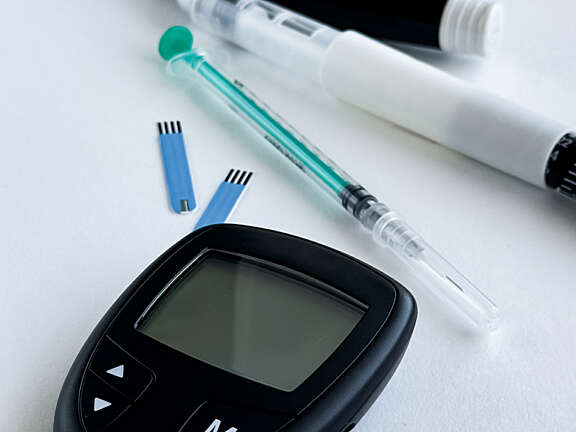Type 2 diabetes is a condition where your blood sugar is consistently higher than normal.
Diabetes Is Common
Nearly 39 million people in the US have type 2 diabetes. Of those, 2.8 million are living in Texas.
How Does Diabetes Happen?
Insulin is a hormone that moves glucose (sugar) from your bloodstream into your cells, where it’s used for energy. If your body doesn’t produce enough insulin, or if your cells become resistant to insulin and don’t allow insulin in, glucose builds up in your bloodstream. This can lead to hyperglycemia (constantly high blood sugar). If left untreated, this can damage your organs and tissues. Serious complications include heart disease, kidney damage, nerve issues, and vision loss.
Causes
Type 2 diabetes is caused by a combination of factors that affect how your body uses insulin.
Insulin Resistance
Cells become less responsive to insulin, meaning they don’t use it effectively. As a result, glucose builds up in the bloodstream instead of being absorbed into cells.
Not Enough Insulin
Your pancreas might not make enough insulin to keep blood sugar in a normal range, especially if your cells are resistant to insulin.
Genetics
If your parents or siblings have type 2 diabetes, you are at higher risk of developing it.
Lifestyle
A poor diet, lack of physical activity, and being overweight or obese are major risk factors. Belly fat especially can make your body resistant to insulin.
Age
While type 2 diabetes can develop at any age, your risk increases after age 45.
Other Health Conditions
Having high blood pressure, high cholesterol, or a history of gestational diabetes (diabetes during pregnancy) can increase your risk of developing type 2 diabetes.
symptoms
High blood sugar can cause one or more of the following symptoms.
Increased Thirst
Your kidneys try to get rid of the extra sugar in the blood by making more urine. This leads to dehydration, which makes you feel thirsty.
Frequent Urination
With too much sugar in your bloodstream, your kidneys have to work harder to filter it out. This leads to more trips to the bathroom.
Hunger
If glucose isn't reaching your cells, you may feel hungry because your body isn’t getting the energy it needs.
Fatigue
If your body can’t properly use glucose for energy, you may feel tired or sluggish.
Blurred Vision
High blood sugar can cause your eye lenses to swell, making your vision blurry.
Slow Wound Healing
High blood sugar can affect your circulation and immune system. This slows down the healing of cuts, bruises, and other wounds and makes you more likely to get infections.
DiagnosIs
All of the following tests check blood sugar levels and can be used to diagnose diabetes.

Fasting Blood Sugar Test
This test checks your blood sugar after you have fasted (not eaten) for at least eight hours. If your blood sugar is 126 mg/dL or higher, it suggests diabetes.
Oral Glucose Tolerance Test
For this test, you drink a sugary liquid, and your blood sugar is checked at different times afterward. If your blood sugar is 200 mg/dL or higher after two hours, it suggests diabetes.
Hemoglobin A1c
This test measures your average blood sugar level over the past two to three months. An A1c level is 6.5% or higher suggests diabetes.
Random Blood Sugar Test
This test checks your blood sugar at any time of day, no matter when you last ate. If your blood sugar is 200 mg/dL or higher, you may have diabetes.
Treatment
Dietary Changes
Your diet plays a huge role. The best food plan for managing diabetes includes vegetables, whole grains, lean proteins, and healthy fats. Also, try to limit or eliminate processed, sugar foods and beverages.
Exercise
Exercise can help your body to use insulin better and keeps your blood sugar in check. Aim for at least 30 minutes of activity each day. If you’re not already active, talk to your health care provider before starting a new exercise routine.
Sleep
Sleep is important for good health and especially diabetes treatment and prevention. Sleep improves insulin sensitivity. Try to get seven to nine hours of sleep each night.
Medication
If lifestyle changes alone don’t help enough, your provider may also prescribe medications. These include metformin, sulfonylureas, SGLT2 inhibitors, GLP-1 receptor agonists, and DPP-4 inhibitors.
Long-Term Insulin
About 25% of people with type 2 diabetes will eventually need long-term insulin therapy. This replace or boosts the insulin your body isn’t making or using effectively. This approach helps maintain a more consistent blood sugar level and lowers the risk of dangerous spikes and long-term complications.
How We Can Help
Your provider should check your blood sugar levels every year as part of your annual physical. If you are diagnosed with diabetes, your provider may partner with one of our care coaches to create a customized plan that includes lifestyle changes, medication management, and monitoring your blood sugar. If you need more advanced or specialized care, you may be referred to an endocrinologist or diabetes specialist. In this case, the team of providers will partner to coordinate your care.
Looking for a provider?
Find one here or call us at
866-325-0301

